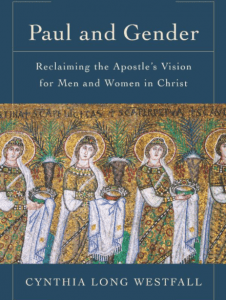 Culture matters and when it comes to an ancient texts it matters even more because that culture is not ours. In her new book, Paul and Gender, Cynthia Westfall investigates culture as a filter we need to rediscover and she then examines what it meant for Paul to ask women to veil.
Culture matters and when it comes to an ancient texts it matters even more because that culture is not ours. In her new book, Paul and Gender, Cynthia Westfall investigates culture as a filter we need to rediscover and she then examines what it meant for Paul to ask women to veil.
Here is a complex sentence but she packs into it a boatload of information vital for what happens in the chapter:
“Cultural and linguistic information about gender is demonstrated through the culture and specifically through the structure of the language, as well as the vocabulary, symbols, and metaphors. However, a culture’s language structure, symbols, and metaphors that involve gender should not be equated with the message of a speaker who utilizes that language. When Paul employs the structure and vocabulary of the Greek language or refers to cultural symbols, metaphors, or practices about gender, we need to be alert as to how much of Greco-Roman cultural practices and worldview are part of Paul’s message, and what cultural assumptions are truly adopted by him” (7-8, my italics).
Westfall sketches Paul in context briefly with some attention to rhetoric and Aristotle and the Greco-Roman view of women, which was fluid but also dependent upon status of a woman and the status of a group. If a group was dangerous the various actions of women would be scrutinized. Thus,
The female version of so-called honor was the primary female “virtue” of shame, which was comprised of deferential behavior, modesty, and chastity that enhanced the honor of the male head of the household (see Sir. 26:10-16; 42:9-12; 4 Mace. 18:6-8; Thucydides, Hist. 2.45.2). … Therefore, when Paul gives honor and recognition to so many female members of the Roman church in Romans 16, it stands out as a significant deviation from the cultural practice and ideal (18-19).
The husband and wife were usually unequal partners in the patronage system in the Greco-Roman world. The husband functioned as the benefactor, and the woman functioned as the inferior party in the marital relationship, unless she brought a large dowry into the marriage. Patronage between unequal pairs often consisted of both authority and reciprocity, which were reflected in the household. The wife received her identity, social position, and a share in the property from her husband and her husband’s family (with the exception of the Roman practice of marrying without manus). The husband received authority and honor in the household, his house was managed, and he obtained his legal heirs from the marital relationship, heirs who would make their contributions to the family economy (20-21). [SMcK: I’m not so sure that marriage is to be explained through patronage.]
Then she turns to space/place and gender: males more for the public and females for the household.
All this is then applied to women, veiling and 1 Cor 11:2-16. Here are her conclusions, which I enumerate:
This study disproves the presupposition in biblical studies that the veil symbolized a woman’s submission to her husband. Wearing the veil was not a private symbol, but rather a public practice regulated by law and custom, and men as well as women were expected to submit to the custom. Briefly, the veil represented a woman’s honor, status, and protection. [Her hair was her glory and beauty; unveiled meant sexually available.] Once the practice of veiling is understood, five things become apparent:
- Men were the ones in the culture who made the laws for veiling, and they thought it was in their interest to prevent certain classes of women from veiling.
- It was (and is) common for women to resist removing their veil because it symbolizes honor and protection.
- It is more likely that women who were not allowed to veil in public would want to wear a veil in the community to symbolize that they were made righteous by Christ.
- Paul’s direction for all women to veil was countercultural and favorable toward women.
- The practice of all women wearing the veil equalized social relationships in the Christian community.
There is now an ongoing debate about how much in this passage is from Paul and how much from his opponents, and Lucy Peppiatt has recently shown (Women and Worship at Corinth) just how contested every line in this passage is. Westfall’s conclusions here are reasonable but so far as I am reading there’s not likely to be a consensus any time soon.
Just the issue of veiling remains contested. Notice this from a note:
However, Craig Keener, in common with Winter, proposes a different kind of class conflict than is argued here; on the basis of Greco-Roman statues of women from this period having unveiled heads, he suggests that upper-class women would show off their hairstyles following the imperial court, while lower-class women would follow a more conservative interpretation of modesty.
Westfall: “Slaves, prostitutes, and freedwomen were prohibited from veiling.” Both of these are from p. 25.















